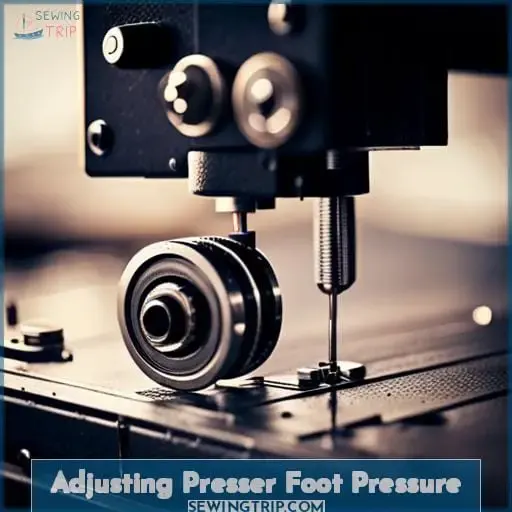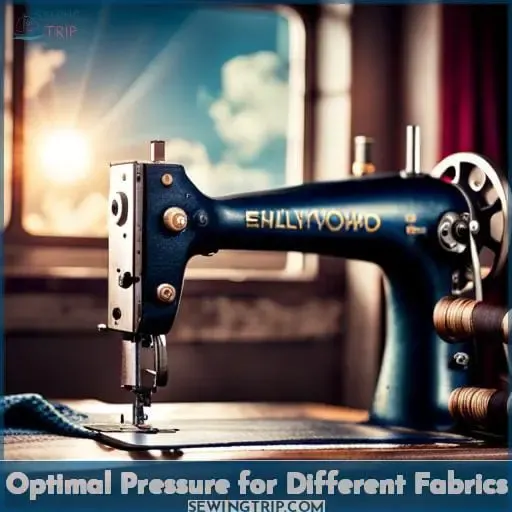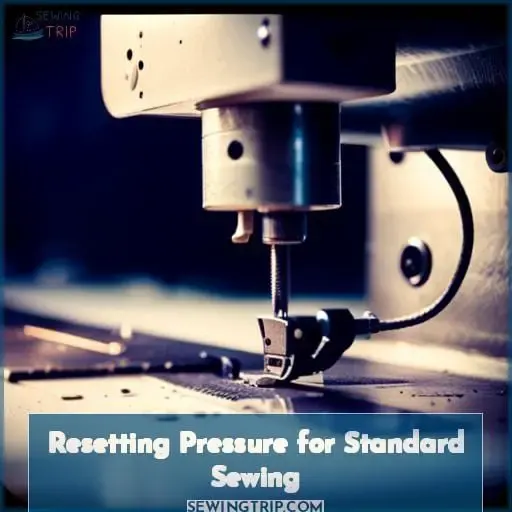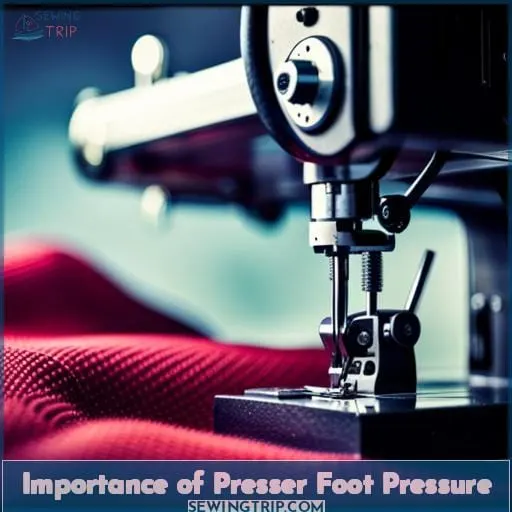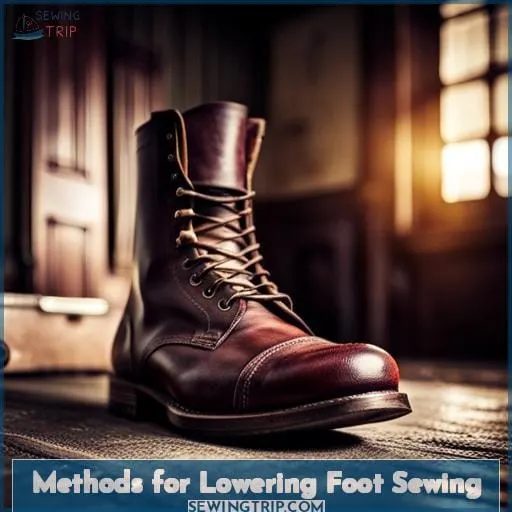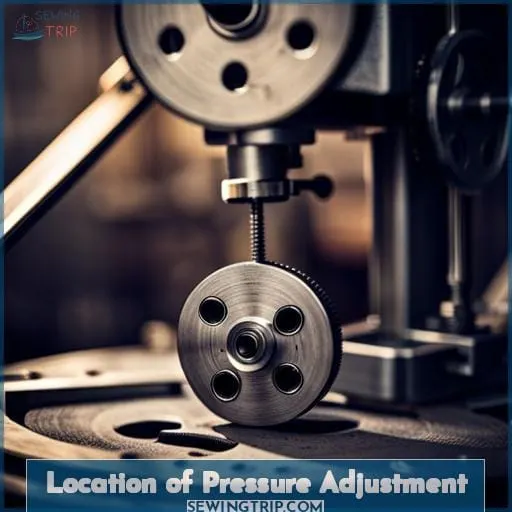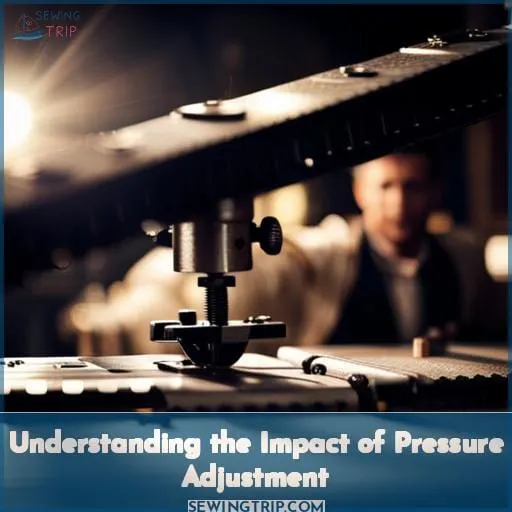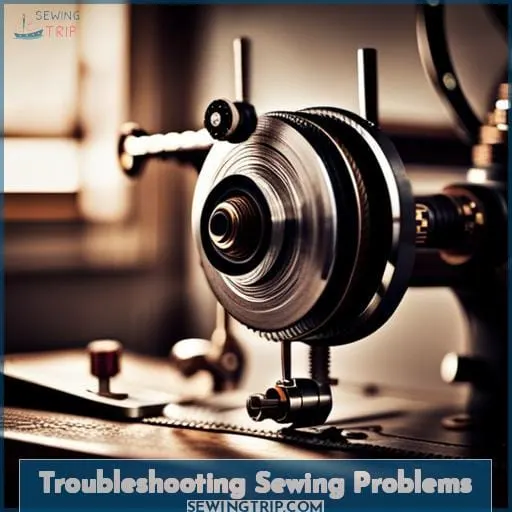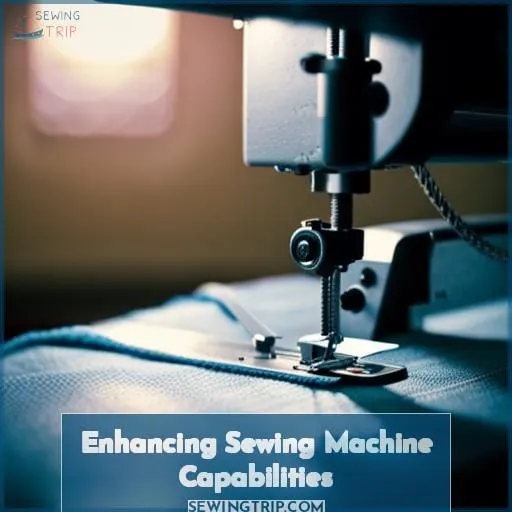This site is supported by our readers. We may earn a commission, at no cost to you, if you purchase through links.
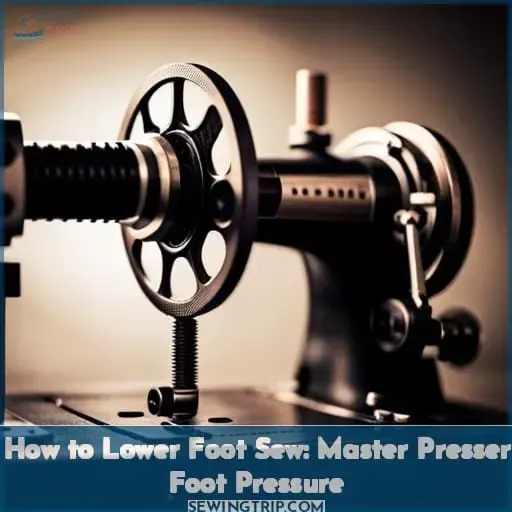 Unlock the hidden potential of your sewing machine and achieve a new level of mastery as you delve into the art of lowering the foot sew.
Unlock the hidden potential of your sewing machine and achieve a new level of mastery as you delve into the art of lowering the foot sew.
For every seasoned seamstress or aspiring dressmaker, this skill is the key to liberation, offering you the power to conquer a vast array of fabrics and materials with finesse.
Whether you’re working with delicate, whisper-thin fabrics or tackling the challenge of heavy, robust textiles, understanding how to master presser foot pressure is your gateway to sewing excellence.
In the world of needle and thread, the ability to control presser foot pressure is your path to mastery. You’ll discover the art of adjusting, the precise location of the pressure dial, and the profound impact it has on your stitching.
So, if you yearn for liberation from sewing constraints and aspire to wield the power of your machine with unparalleled mastery, join us on this journey to unravel the secrets of lowering the foot sew.
Table Of Contents
- Key Takeaways
- Adjusting Presser Foot Pressure
- Optimal Pressure for Different Fabrics
- Resetting Pressure for Standard Sewing
- Importance of Presser Foot Pressure
- Methods for Lowering Foot Sewing
- Location of Pressure Adjustment
- Understanding the Impact of Pressure Adjustment
- Troubleshooting Sewing Problems
- Enhancing Sewing Machine Capabilities
- Conclusion
Key Takeaways
- Use higher pressure (3 or 4) for thin fabrics to ensure proper fabric control.
- Opt for lower pressure (1 or 2) when working with thicker fabrics for improved precision.
- Reset the pressure to standard (3) when sewing on smooth fabrics for consistent feed.
- Explore your sewing machine‘s pressure adjustment options, which may include dials, levers, or buttons, to customize your sewing experience.
Adjusting Presser Foot Pressure
Feel the power at your fingertips as you fine-tune the fabric’s embrace, ensuring it dances smoothly beneath the machine’s touch with the presser foot pressure adjustment dial.
Lowering the foot sew is an art, granting you the liberation to master your sewing projects.
Understanding the benefits of presser foot adjustments is key. The pressure settings can make or break your sewing efficiency, allowing you to effortlessly work with a variety of fabrics. For thinner materials, increase the pressure, choosing settings like 3 or 4 for that added power.
When handling thicker fabrics, dial it down to 1 or 2, granting you the mastery to maintain control without causing undue strain on your machine.
But it doesn’t stop there; troubleshooting tips are your secret weapon. Should fabric pressure become a concern, knowing how to adjust the presser foot’s pressure settings, whether through an adjustment screw or electronic adjustment, will ensure your projects proceed flawlessly.
So, seize the power to lower the foot sew and master the art of sewing with precision.
Optimal Pressure for Different Fabrics
When working with different fabrics, mastering the art of presser foot pressure adjustment is essential for achieving impeccable sewing results. For delicate, thin fabrics, set your machine’s pressure dial to the higher settings (3 or 4) to ensure a firm and even fabric feed.
Conversely, when working with thicker fabrics, lower the pressure to settings 1 or 2, allowing for smoother stitching and preventing fabric distortion.
Thin Fabrics
To achieve optimal results when working with thin fabrics, you’ll want to set the presser foot pressure dial to a higher setting, typically around 3 or 4 on the scale. This higher pressure ensures better fabric feeding and behavior, granting you sewing control and liberating you from the frustration of uneven stitches and fabric misalignment.
With mastery of foot pressure adjustment, your stitching on delicate materials will exhibit the power of professional quality and precision.
Thick Fabrics
When working with thick fabrics, remember that higher presser foot pressure settings are the key to achieving the best results. To conquer the sewing challenges thick fabrics present, master the art of adjusting fabric pressure.
Start by lowering the foot, ensuring it firmly grips the fabric. Use expert presser foot techniques to maintain control. This sense of liberation and mastery over your machine will empower you to sew through heavy materials with ease, producing flawless results.
Resetting Pressure for Standard Sewing
Adjusting the presser foot pressure to the standard setting of 3 is essential to ensure smooth and even fabric feeding during your sewing projects. This step is where you take control of your sewing machine, and it’s a pivotal aspect of achieving sewing mastery.
Here’s what you need to do to reset the presser foot pressure to standard:
- Reach for the presser foot control, and lower it gently. Feel the precision in your fingers, the mastery in your touch.
- Turn the dial at the back of the machine to the number 3, where it belongs. Embrace the liberation of knowing you’re in charge.
- Choose your fabric with care, align it under the foot, and let your sewing results speak of your expertise.
- Start your stitching journey, and revel in the power you have over your machine, knowing that with the standard pressure, your fabric will flow effortlessly.
As you reset the pressure for standard sewing, remember that it’s not just a technical adjustment; it’s a statement of your sewing prowess and the path to perfect stitches.
Importance of Presser Foot Pressure
Understanding the importance of presser foot pressure is like finding the right balance for your sewing machine’s performance. It’s the key to achieving fabric stability and sewing precision, unlocking a sense of liberation in your sewing endeavors.
The control it offers over the pressure exerted on your fabric is a source of power, enabling you to conquer various materials with ease. Proper presser foot pressure brings multiple benefits to your sewing, enhancing your mastery over the craft.
It ensures sewing efficiency, preventing fabric slippage, and guaranteeing even stitches.
This control is particularly essential when dealing with different fabric thicknesses and sewing techniques. Whether you’re creating delicate hems or tackling heavy-duty projects, understanding how to lower the foot sew by adjusting the presser foot pressure is a skill that empowers you to take charge of your sewing machine, elevating your mastery of this timeless craft.
Methods for Lowering Foot Sewing
To achieve the perfect stitch, it’s essential to familiarize yourself with various methods for adjusting the presser foot on your sewing machine. Lowering the foot sew is a crucial aspect of sewing mastery, offering you a sense of liberation and power over your craft.
Here’s how to do it with finesse:
Start by selecting the right presser foot for your project. Different feet serve different purposes. Once you’ve chosen the appropriate one, pay close attention to stitch settings and adjust your mechanical sewing machine accordingly.
Understand the nuances of presser foot pressure and its role in fabric handling, which is vital. Increase or decrease the pressure as needed to achieve optimal results – higher pressure for heavy fabrics, lower for delicate ones.
Additionally, ensure your sewing accessories are in top condition, and remember that foot adjustment insights can be your secret weapon. These presser foot best practices ensure that every stitch you create is a masterpiece.
So, lower that foot, sew with confidence, and relish the mastery it brings to your sewing endeavors.
Location of Pressure Adjustment
Locate the position of the presser foot pressure adjustment on your sewing machine by checking for a dial, lever, or button according to your model.
Mastering this feature grants you liberation, power, and mastery over your sewing projects. Understanding the location of the presser foot adjustment is essential for achieving precise and flawless sewing techniques.
The presser foot adjustment is a key element in controlling fabric pressure, ensuring that your sewing machine’s performance matches your project’s requirements. Whether it’s a dial, lever, or button, this feature allows you to fine-tune the pressure, preventing issues like uneven fabric layers, skipped stitches, and thread breakage.
Consult your sewing machine’s instruction manual for specific guidance on the location and operation of the presser foot adjustment. By doing so, you’ll be one step closer to harnessing the full potential of your sewing machine and achieving the results you desire in your sewing endeavors.
Understanding the Impact of Pressure Adjustment
Adjusting the presser foot pressure on your sewing machine can significantly impact the quality and ease of your stitching, allowing you to achieve excellent results, especially when working with different fabrics. Here’s what you need to know:
Fabric Control
Proper pressure settings grant you control over the fabric, ensuring it feeds evenly and smoothly under the presser foot. Higher settings are ideal for delicate, lightweight fabrics, while lower settings are perfect for heavier materials, preventing distortion.
The right pressure adjustment is your key to sewing precision. It prevents issues like skipped stitches, thread breakage, and uneven fabric layers, ensuring your stitches are even and accurate.
Sewing Efficiency
Understanding the impact of presser foot pressure adjustment can significantly enhance your sewing efficiency. It allows you to tackle a wide range of sewing tasks with ease, from quilting to sewing over thick seams, all while maintaining the quality and consistency of your work.
Mastering this adjustment empowers you to unleash your sewing prowess, providing liberation, power, and mastery over your craft.
Troubleshooting Sewing Problems
When troubleshooting sewing problems, it’s like solving a puzzle to ensure your stitches are perfect, and your fabric flows smoothly. As a master seamstress, you understand that achieving sewing mastery requires finesse in addressing common issues.
Here, we’ll delve into essential tips to overcome those pesky hiccups.
Table: Troubleshooting Sewing Problems
| Problem | Solution |
|---|---|
| Stitch Quality | Check needle and bobbin tension. |
| Bobbin Tension | Adjust bobbin tension as needed. |
| Thread Selection | Choose the right thread for your fabric. |
| Needle Care | Ensure your needle is sharp and suitable. |
First, assess your stitch quality. It’s crucial to ensure both your needle and bobbin tension are correctly set.
Next, be meticulous in your thread selection, matching it to the fabric’s needs.
Lastly, don’t overlook needle care – a sharp, appropriate needle can work wonders.
These steps empower you to tackle the most intricate sewing projects with confidence and expertise. As you master the art of lowering the foot for a flawless sew, you’ll experience the liberation and power that comes with becoming a true sewing aficionado.
Enhancing Sewing Machine Capabilities
To enhance your sewing machine’s capabilities, consider exploring the various presser foot pressure adjustment options available on different models, which can be a game-changer for achieving flawless stitching results on a wide range of fabrics.
Whether you’re a seasoned seamstress or just starting your sewing journey, mastering this feature can unlock a world of possibilities.
Here are some expert tips to help you make the most of your sewing machine:
- Sewing Techniques: Understand the right presser foot pressure for each sewing task. Higher pressure for delicate fabrics and lower pressure for thicker materials ensures precision in every stitch.
- Fabric Selection: Tailor your presser foot pressure to the fabric at hand. This skill grants you the power to work with various textiles, from lightweight silks to heavy denims, without a hitch.
By harnessing the presser foot pressure adjustment and honing your sewing skills, you’ll experience a newfound sense of liberation, power, and mastery in your sewing endeavors. Your sewing machine will become a tool of endless creative embellishments and stabilizing stitches, making your projects a true masterpiece.
Conclusion
In your journey to mastering the art of sewing, you’ve delved into the intricate world of presser foot pressure adjustment, a skill that can truly elevate your sewing prowess.
From delicate fabrics to the thickest of materials, you’ve learned that the key to impeccable stitches lies in understanding and fine-tuning this essential feature.
As a master seamstress, you know that the magic happens when you grasp the optimal pressure settings for different fabrics.
Whether you’re working with the finest silks or heavy denims, your ability to lower the foot and adjust the pressure ensures a smooth and precise sewing experience.
Don’t forget the importance of resetting the pressure dial to its standard setting after working with those delicate materials.
Now, with the knowledge of where to find the pressure adjustment on your sewing machine, you’re equipped to troubleshoot any sewing issues that may arise. Uneven stitches, skipped stitches, or fabric feed problems become mere challenges to overcome.
In the grand tapestry of sewing, understanding and mastering presser foot pressure adjustment is the thread that binds it all together.
As you enhance your sewing machine’s capabilities with this skill, your creations will reflect the work of a true professional, a master dressmaker who has harnessed the power of the presser foot.
So, as you lower the foot to begin your next sewing project, remember that you hold the key to masterful stitching in your hands – the art of presser foot pressure adjustment.

